
Story by Chris Hector and photos by Roz Neave & Archives
Mary Hanna’s husband, Gert Donvig (who was tragically killed in a car accident in 1988) had won a scholarship to train in Germany and it was there that he met the famed dressage trainer, Siegfried ‘Bimbo’ Peilicke. After Gert had been ruled out of riding their stallion, Kilof McOhl in the Haig Cup – on the grounds that he was a ‘professional’ – Mary got the ride and soon developed a taste for dressage. So much so, that she travelled to Germany with the second stallion she and Gert bought, another Danish Warmblood, Granada.
“Bimbo had been out in Australia training, and we said to him ‘do you think you can get this horse to change to the left?’ He said he could, so off went Granada for a year, then I followed and stayed a couple of months. I did learn a lot because we were riding right at the DOKR in Warendorf – Isabell Werth and many of the good riders were there, you watched good riders every day, and it was great to be part of the whole training system.”
“But the disappointing thing was that Granada was doing late changes one way when he left Australia, and a year later, he was doing exactly the same. He was doing pretty nice piaffe and passage however. It was great though, it improved my position and gave me the opportunity to learn about the techniques of training.”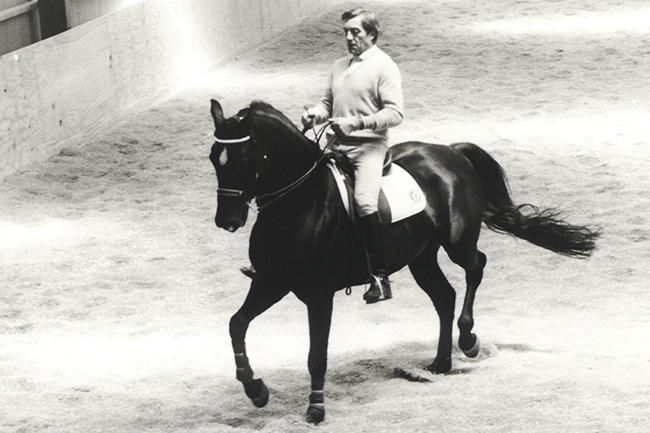
Bimbo and Granada – working at Statene Park, but back home, still no change to one side!
And the professionalism of the riders – was that a shock?
“It wasn’t a shock, I just loved it. I love that when I go to Europe and I see everything is done properly – the whole discipline of the system, I like that. It’s not something I learned as an event rider in the Western District! You just flung the saddle on and off you rode, and if your horse had a bit of mud on it, you didn’t care – you didn’t care what you were wearing, just get out there and jump a fence. I had to learn that whole European way of doing things, but I’ve really taken it on board, and I love it. To be a good dressage rider, you must have that complete discipline in everything you do.”
The next horse?
“Then I had Duell Silk. I took him to Grand Prix – if I knew then what I know now, then I would never have sold him, but it was the first horse I did with Justice Ken Marks and the whole point of the operation was for the horse to be sold to make some money. It was a business arrangement and I knew that from the beginning, but I think we could have waited one more year for the World Championships and got more money. I knew it was a business arrangement and the Japanese came along and offered a really good price, so we sold Duell Silk, then Ken decided this was a pretty good thing – he was really enjoying owning a dressage horse, so we went up to the NSW Equestrian Centre Auction and bought Welcome Stranger.”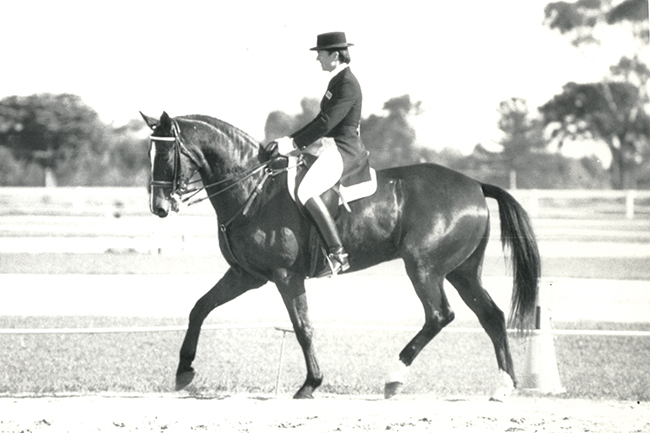
Mary and Duell Silk – and the great association with Ken Marks was born…
Justice Marks had actually trained Duell Silk to quite a high level with Art Uytendaal…
“He most certainly did, and he was his own biggest critic, and that was a bit of the problem with Duell Silk, because he was actually a very good horse, but Ken was very critical. One day I asked him why he didn’t compete and he said ‘I’m a judge, I judge people they don’t judge me’. He was quite critical of all the horses, not in a bad way but he’d say ‘oh I think it’s not quite through the back’ or ‘it should be more relaxed’, he was tough, it had to be really really correct. There’d be some little thing with every horse and in the end we’d sell it.”
“Welcome Stranger went Grand Prix and he was a lot of fun, he was a very beautiful looking horse, and quite talented in piaffe and passage. Again, we got right up there and maybe we should have persevered, Bimbo really liked that horse, but again the Japanese came along and offered good money. It was a business, we had to sell horses to pay the bills.”
The first really international horse is Mosaic…
“We took the money out of Welcome Stranger, and Ken invested in Solo as a young horse, and I re-invested my part in Mosaic.”
And that was a very unlikely horse to take to the World Games and Olympics – out of a pony mare…
“That was very funny because Clemens Dierks kept saying ‘Mary you must buy this horse’, so alright Clemens – over I went and I looked at him and said – sorry I just can’t buy him. I’d always had beautiful horses, nice looking big horses with nice fronts on them and good necks. It was just my upbringing, you looked at a horse and it had to be put together properly, everything in the right place and some presence about it. In those days, Mosaic had a scrawny little neck, a pot belly, he was the funniest looking little thing and just I couldn’t envisage myself going to any Olympics on that horse. So I came home, and the next time I saw him was in Canberra, in the Grand Prix, I remember Ricky MacMillan was there too, and we watched him in the test, and Ricky said ‘Mary you can’t buy that horse’ – but when he moved he was magical. He just had the mechanics, his movement was so good that as he was moving you didn’t see the funny little pony.”
“When I saw the way he moved in the arena, how he filled the space by the mechanics of his beautiful soft movement, he had something really special when he moved. Clemens, as he so often is, was right. There have been lots of trainers in my life, but it is Clemens that I keep going back to – I owe him such a lot.”
But wasn’t Mosaic one of those horses that the vet said ‘no he doesn’t pass the vet check’?
“Robbie (Mosaic) did fail his vet check. The vet said ‘look he’s got ring bone and at some stage in his life, he is going to limp’ – well, he did limp, but he was 23 when he started limping. The vet was correct but the time frame worked out okay.”
But if you’d let the vet check freak you, you would have missed out on an Olympic and WEG horse…
“It might have changed my whole life… The first thing we did together was the WEG in Den Hague – Maurice Bruce, Judy Dierks and I were in the team. It was hysterical – I’d never been so hot in my life, and nothing was ready – but we hadn’t been anywhere before so we thought it was wonderful. Poor Judy rode into the arena as the first competitor and they were still hammering the signs on the fence, and we were first on the next day. But I didn’t know any better, I was hooked.”
“I went to three World Cup finals in a row on Robbie: 1996, 1997 and 1998. I did the first World Cup in the lead up to Atlanta, it was in Sweden, and I stayed up there with Kyra Kyrklund getting ready for the Olympic Games. At that time I almost made a huge mistake, I was buying another Danish stallion, Vancouver at the time, and the Japanese agreed to buy Robbie. I was ringing up Rob (Mary married Rob Hanna in 1990) at the time and saying ‘I don’t want to sell him, I think he’s better than the one I am buying’, luckily the deal fell through.”
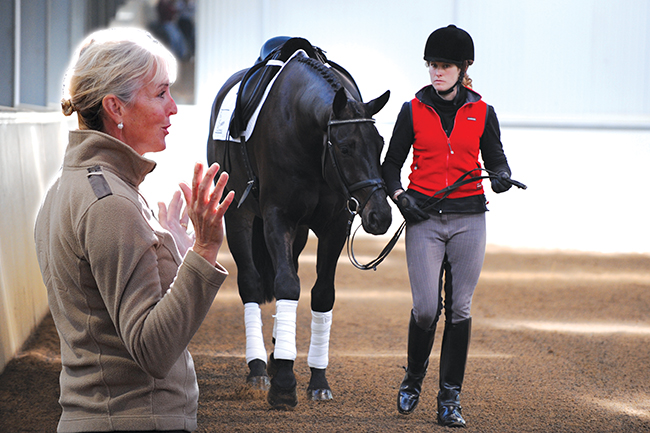 The young horse under saddle…
The young horse under saddle…
Mary produced her next equine student, with a somewhat embarrassed air. Even when the rest of the Australian dressage riders tended to ride elephants, Mary liked her horses refined and elegant… and her Dutch four year old Ambassi (by the Sandro Hit son, Samba Hit out of a Dutch mare by the dressage stallion, Havidoff) is… er… not what anyone would call either refined or elegant at this stage in his life. To tell the truth, he’s a bit more like an elephant…
But beauty is as beauty does, and Ambassi is now going well under saddle, although he had his moments getting there:
“I had a Finnish girl working here before and she had never really broken a horse in, but she was a reasonably competent rider with young horses, so I went all through it with her. She was pretty nervous, and he is a big strong boy and did do a couple of serious bucks on the lunge, so with him I long reined him and I had the Pessoa gear on him, because he was quite sensitive about things around the back of him. She never got bucked off while I was standing here telling her what to do, but one day, I guess she took it a bit easy and just jumped up on him, and he planted her good and proper, so we are just a little careful with him.”
It’s Mary’s new stable rider, Lisa Dowling, who is in the saddle:
“Lisa, just walk him around for a few minutes and get him to relax – then he’s fine, but he is a big strong growing four year old and you don’t take anything for granted. Also Lisa has only been with me for a couple of weeks and she said to me when she came that she’d had a few bad things happen and she didn’t want to be put on a horse that was going to be stupid. I don’t want to upset the horse, and I don’t want to frighten Lisa.”
How many days a week do you work a four year old?
“Four days some weeks, five some weeks, it just depends on what is happening. If the weather is nice, he can go out in the paddock for the day. I wouldn’t want him to be worked six days a week. When we are breaking them in, they are probably done six days a week if they are a bit ansey and you want to have them feeling a little more humble about life. But because he is so big, I try to do minimal work because he is growing so fast, I’ve never seen a horse grow so fast.”
“I bought him because he was a super mover, had really good bending in the joints, and a naturally very nice canter and good bend and lift in the trot. Since being broken in, he has lost the trot quite a lot, but I think that is not just being broken in, it is because he is growing so much. He does have a very nice canter, and you can see moments when he can collect that enormous body, that the canter is going to be special… Kyra Kyrklund always used to say to me, you can make a trot, you can’t make a canter or a walk. Well he has a canter and walk, and he did have a very good trot and at the moment he is like a great big teenage child, he doesn’t quite know where to put his legs, but he’ll be right in a year.”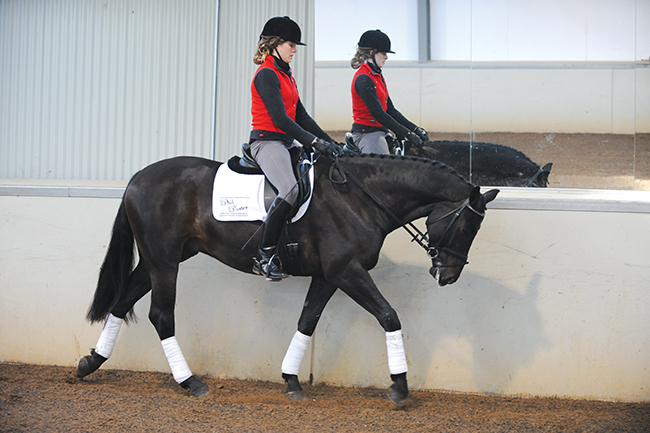
So after all these modern horses, now we have the ‘retro’ model…
“That was an accident but I’ve ridden him quite a lot, and he is sensitive, so he’s not old fashioned that way. He might be enormous but when I sit on him, he’s not too wide, and he is not lazy, and if he is not lazy now he’ll never be lazy. You might expect a great big horse like that to be lazy when you break him in, but he has never had a lazy moment. It’s funny because Clemens Dierks came down to do a clinic, and I said, oh Clemens, I’ve made such a mistake, I’ve bought the ugliest young horse in my whole life. He said, you get on and ride it, so I rode this one in the lesson, and Clemens said, I don’t know what you are talking about, that’s a good German horse!”
“That’s the thing, to go and find the young horses and choose them yourself. It’s just a real challenge, trawl through Europe, finding a young horse for a reasonable price – that’s the first challenge. Bring them home, break them in, is the next challenge. Then assess them and see how they turn out. And at the moment there are three horses competing Grand Prix: Tango, Oscar B and Mayfield Pzzazz, that I’ve selected, broken in, got started, and they have all gone Grand Prix and I’m pretty happy about that. People say, oh you must hate it that you’ve sold those horses on, but it gives me great satisfaction to see Kerry and Pizazz and Kate and Oscar going so well, and I’ve got my Tango, and I love Tango. I adore Tango – I kept him because that’s the horse I relate to, that I adore riding and training, that’s what it is all about, the satisfaction of training the horse, the enjoyment and the challenge of training a horse to Grand Prix. I don’t want buy a horse that is just going to go to Prix St Georges. My challenge is to find a Grand Prix horse and train it, but I want to do it right from the start…”
It was time to concentrate on Lisa and Ambassi…
“Make sure you have him into the two reins, that you have equal connection, that he is not heavier on the left. The first thing you’ve got to do is find rhythm, he won’t have a correct rhythm until you get the connection and have him forward and into the bridle. There, you are doing a good job.”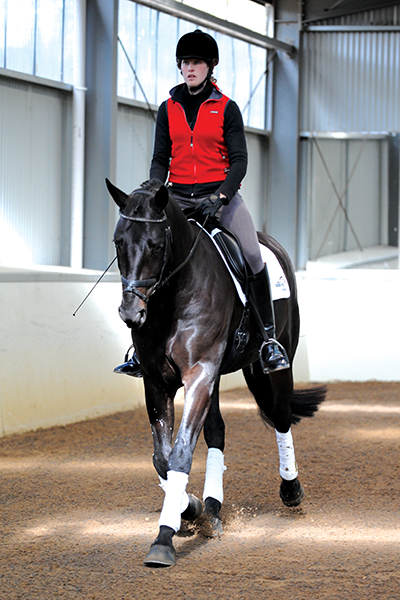
“If you feel any irregular steps, that means he is not truly through. He’s not quite into the bridle yet. It’s no hurry, take your time, feel your way and feel a nice elastic connection in both reins. That’s a nice frame to start with and he’s into the two reins, perfect. Take your time, warm him up a bit, on both reins, make a few changes of direction and feel him into the rein. When you are on the right rein with him – because he likes to hang a little left, then we will keep a connected right rein, don’t make the right rein too soft. Into the right rein and then soft on the left.”
Mary is happy with the way the work is progressing:
“Lisa is doing a good job, she is obviously not a left rein hanger. Unfortunately the horses pick up the habits of the people who break them in… then you have to sort them out, but Lisa is doing a good job.”
“We can start now to put him a little more into the right – you can come on the quarter line, first of all straight on the quarter line and keep the balance. In the corners, turn with the outside aids – first he must just go straight on the line. Good, very good. Turning with the outside aids, don’t just pull on the left (inside rein). If you pull on the inside rein to turn, he loses balance. You have to really concentrate in the corners that he doesn’t lose rhythm. Every step should be the same. Good. Turning on the quarter line again, turning on the outside aids, go straight a few steps, then a leg yield back to the wall, now he has to step into the right rein from the left leg. Just a few steps that you connect him to the right rein.”
“On the next long side you can ride him forward, and then come back a few steps – just so he is paying attention, that he can lengthen and then come back a few steps. The rhythm is the same, the steps just become a little shorter. Go large and we’ll do that leg yield again. Turning again, nice straight line on the quarter line, very straight and then stepping across into the right rein from the left leg. Well done, not too high with your hands, if he comes a little low, then you have to ride him up from the back end, not pull up the front end. And don’t forget the little transitions, come back a few steps before the corner, balance and then every step the same in the corner. Next time you can come on the centre line and make the leg yield, good, it just helps to engage him a little bit more, step under.”
“Again, turn on the centre line, turn on the outside aids, and across, push the shoulder to the outside rein. He was a little bit hoppy there, don’t sit, stay rising in the leg yield – when you sat, that was when the steps became irregular and he became tight in the back. It is not necessary to sit in the leg yield, stay rising – most important is that you have regular steps, the regularity of his steps when he moves away from your leg is really important. Okay and coming across into the outside rein, even steps, yeah, and be soft on the left. He is still not quite enough into that outside rein, ride the whole thing a little more forward, forward and even steps, come again. Relax in your body, don’t be tight when you ride leg yielding. Relax your upper leg and just tap him a little with the lower leg. If you get tight then that tightness goes through to the horse.”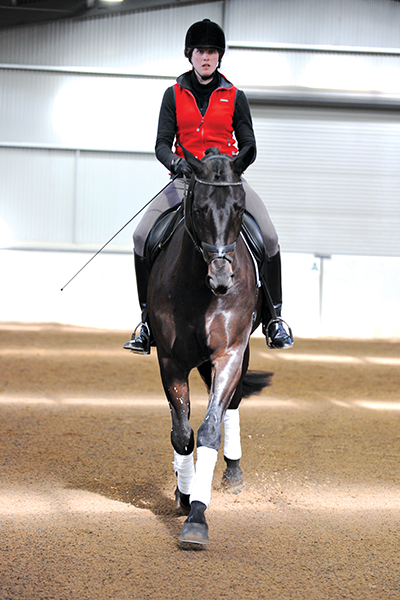
“Come back to a few steps, walk, and then trot him on again – don’t pull him back to walk, sit and keep the same connection and drop your weight a little. Okay trot on – if you just trot round and round and don’t make any half halts, he’ll start fall on the forehand, come back, sit on the hind end, then on again. When you come back he has to stay active behind, not just go out the back. Okay, quarter line… he is very sweet in his temperament for a four year old. He’s got the Brentano good temperament (his sire Samba Hit is out of the Brentano mare, Poesie – and is the full brother of the World Champion, Poetin), and it doesn’t matter what he looks like, if he hasn’t got the brain to learn. He’s just a big ugly duckling, when he matures he’ll look fine, I think he might be quite handsome one day.”
“There, now he is loose and swinging, relax your right rein. Now take a little break, and when he walks, following with your hands and marching. He’s got a huge walk so you have to follow with your hands, stretch him forward and down. Super super walk, and super canter. He’s over-tracking at least a foot there, swing through with your hips and follow with the hand. He’s really steady in the mouth, he always has his mouth closed and he is chewing on the bit, the connection is good – and I think Lisa has a really good feel for connection.”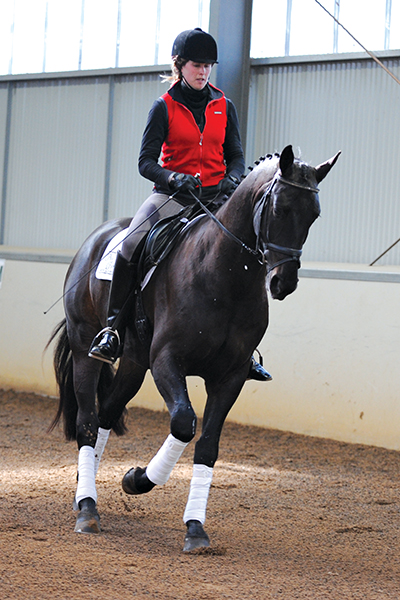
“Now pick him up a little, and we’ll work a bit on the canter. I know that not everyone will agree with this, but because he is so big, in the canter, I do a lot of work going walk / canter, if you let him long and out, he just can’t do it, it is physically impossible for him – he has to sit on his hindquarters or canter is an impossible movement for him, because he’s going to fall on his face. So we work a lot on the walk to canters, so that he learns to come from the first step, underneath himself, and then it is much easier for him to balance.”
“Prepare for the canter, make him more engaged behind, you’ve got to collect the walk a little bit. When you make the canter, do not tip your upper body forward, sit back, sit down through the inside seat bone, and make the canter transition through your hip. Collect, prepare, wake him up, he doesn’t look as though he thinks you are going to canter, and when you feel the right moment, canter on the circle. Sit in, collect and CANTER… Well done.”
“Then you’ve got to make those little half halts, sit in, keep his hindlegs sitting under, super. Don’t let his shoulder fall through the outside rein. Just a little more activity, that’s it – you still have to cover some ground. He’s not a medium horse yet, he’s got to cover some ground but keep the hind leg under – little half halts. He’s a bit short in the neck, push the nose forward, don’t pull back at him – now the frame is good. Prepare for walk, sit, collect, collect with your seat, and to walk. Walk five or six steps and then canter again.”
“He has to stay on attention in the walk. Ready, sit deep, hip, seat, canter, well done. He has to stay active. We don’t want a big slow canter, we want the hind leg jumping under. Pat him good well done, now go large and keep those little half halts to feel in balance, all the time not on the forehand. Sit deep, sit in, keep your inside heel down a bit, and the inside leg a fraction forward. Sit back, use your lower back a little more, very good. Really nice canter.”
“On the next long side you can ride a small counter canter loop, just an easy one. Half halt, sit, now a little loop, turning him with the outside aids, keep your inside leg forward and your heel down. Go straight the next long side and we’ll do that again. A little forward and uphill, good, he’s got to cover some ground – come, that’s it, and loose again. That’s good he still has to cover ground in the canter. Now you can relax to trot, relax, sit, don’t pull, and forward to the trot. Well done, change rein… and then you see a bit of trot come after the canter. Good, lovely frame, go a little forward in the trot, rising or sitting whatever is easiest, then come back, and you start to see a bit of knee happening… I’m sure it’s there, I’m sure it’s going to come back.”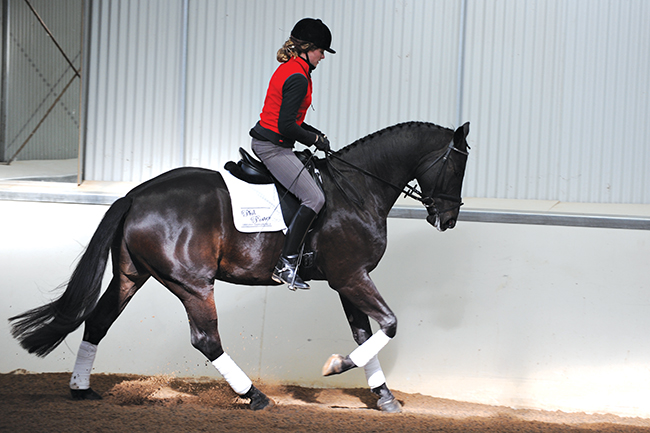
“Just be careful with your inside leg, you’ve got a little tendency to bring the heel up and draw your knee up. Keep your leg long… You’ve got nice long legs so impress the judges with longer legs. Seriously it is not about that, it is actually about using your back correctly. You can’t use your back correctly once you start to draw your leg up.”
“I wouldn’t do walk canter like this with a horse that was smaller and quicker, it is because he is such a big horse – this is the way for him. I don’t do the same thing with every young horse. He is able to carry himself now… and sit, sit, sit to walk, and that is coming better, he is staying a little more on the hind end in the transition down. He’s super sensitive, you can’t touch him with a whip, we have to get him over that – but it is a good thing because when you need that, it’s there.”
“Okay when you are ready, sit and canter, well done, the transitions are getting better and better now. If he comes behind you’ve just got to sit in a little bit, and don’t be tempted to bring your hands too high – the hand too high makes him come more behind the vertical.”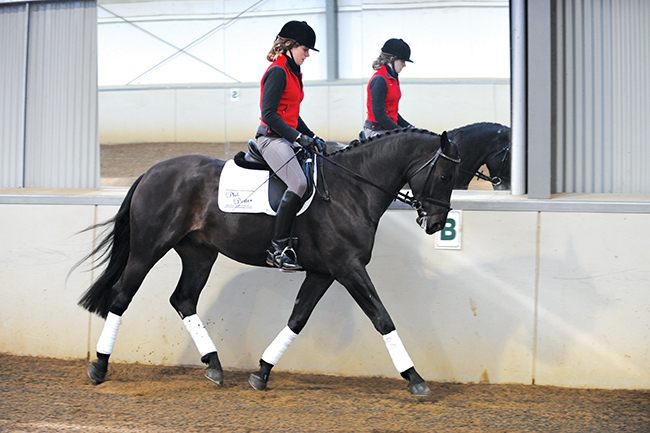
“Go large and the next long side, you can ride your little loop. Back with your upper body – good. Little loop, keep slight left flexion but soft left. That little counter canter loop helps develop the canter. You must keep the left flexion, otherwise you are just teaching him to canter on the wrong lead, and we don’t want that. Counter canter must be ridden, it’s not cantering on the wrong lead. Keep the flexion and bring him back to the track with your left leg.” “That’s enough. Just trot him forward and loose. If you looked at him standing a few months ago, that was seriously ugly, and he was so bad when he was just broken in – he was so out behind with his hind legs. I went ‘Oh my god, what have I done…’ But it is all starting to happen now .”
This article first appeared in the September 2009 article of THM.

